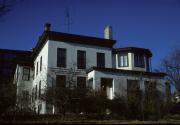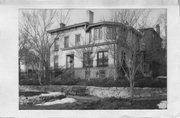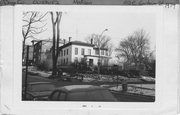Property Record
102 E GORHAM ST / 411 N Pinckney St
Architecture and History Inventory
| Historic Name: | Lansing W. & Melvina Hoyt Residence |
|---|---|
| Other Name: | Madison Community Coop |
| Contributing: | Yes |
| Reference Number: | 37082 |
| Location (Address): | 102 E GORHAM ST / 411 N Pinckney St |
|---|---|
| County: | Dane |
| City: | Madison |
| Township/Village: | |
| Unincorporated Community: | |
| Town: | |
| Range: | |
| Direction: | |
| Section: | |
| Quarter Section: | |
| Quarter/Quarter Section: |
| Year Built: | 1853 |
|---|---|
| Additions: | 1889 1871 1883 |
| Survey Date: | 1991 |
| Historic Use: | house |
| Architectural Style: | Italianate |
| Structural System: | |
| Wall Material: | Brick |
| Architect: | |
| Other Buildings On Site: | |
| Demolished?: | No |
| Demolished Date: |
| National/State Register Listing Name: | Mansion Hill Historic District |
|---|---|
| National Register Listing Date: | 6/4/1997 |
| State Register Listing Date: | 2/11/1997 |
| National Register Multiple Property Name: |
| Additional Information: | A 'site file' exists for this property. It contains additional information such as correspondence, newspaper clippings, or historical information. It is a public record and may be viewed in person at the Wisconsin Historical Society, State Historic Preservation Office. Madison Historic Landmark: 1/31/1972. Map code is 070914404135. Elisha Keyes, a Republican politician, lived here from 1867-1914. This brick Italianate style house was built in 1853-1854. It was later occupied by Elisha W. Keyes who made extensive additions and alterations to the house. Keyes was appointed postmaster by Abraham Lincoln in 1861, serving for twenty years. He was elected mayor of Madison in 1865, the city's first Republican in that position. He also served as a University of Wisconsin Regent from 1877 to 1889; state assemblyman in 1882; Madison's mayor a second time in 1886; and municipal judge 1889-1893. "The rambling brick Italianate style house was built for local speculator Lansing W. Hoyt, and his wife, Melvina, in 1853. It was later occupied by Elizabeth M. and Elisha W. Keyes who made extensive additions and alterations to the house. Keyes was a powerful state political "boss" who was appointed postmaster by Abraham Lincoln in 1861, serving 20 years in that position. In the 19th century, postmasters wielded a great deal of political power because they controlled many jobs that they could give to political supporters. Keyes was elected mayor of Madison in 1865, the city's first Republican in that position, and was reelected in 1866 and 1886. He served as a University of Wisconsin regent, state assemblyman, and municipal judge. In the Progressive era, "Fighting Bob" La Follette made Keyes the symbol, somewhat undeservedly, of the political corruption of big business. The original front yard of this house has been preserved as a Period Garden Park. Area residents campaigned successfully to protect this open space after plans to build a large apartment house on the site were announced." Madison's Pioneer Buildings: A Downtown Walking Tour, 1987. |
|---|---|
| Bibliographic References: | Sandstone and Buffalo Robes: Madison's historic buildings, third edition, 1975. Madison's Pioneer Buildings: A Downtown Walking Tour, 1987. |
| Wisconsin Architecture and History Inventory, State Historic Preservation Office, Wisconsin Historical Society, Madison, Wisconsin |



